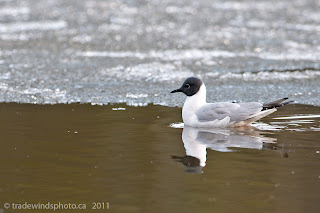Welcoming folks to the 8th annual Sheep and Crane Festival in Faro
Thousands upon thousands of sandhill cranes fly overhead
Kettling over Faro (cranes riding the thermals)
Small flock of sandhill cranes fly across the Tintina Valley
The view of the Tintina Trench from the Mineral Lick
Trees of the Tintina Valley
Prairie Crocus in bloom
Mew gulls gather at the Sewage Lagoon
Bonaparte's Gull
Male and Female Barrow's Goldeneye
A dark-eyed junco singing his tiny heart away
Finally, an update from my fabulous outing to Faro!
Last weekend three friends of mine from Ottawa joined me in Faro to take part in the 8th annual Crane and Sheep Festival. Thousands upon thousands of migrating sandhill cranes, a handful of Fannin's Sheep grazing on the mountain slopes and plenty of good ol' fashioned community hospitality were some of the many memorable highlights.
The town of Faro, located some 300km northeast of Whitehorse, is a former mining community. Established in 1969, Faro was the site of a major lead-zinc deposit. In its heyday the town was home to over 2,000 residents - today, the number has dwindled to just over 500 (the mine has long since closed). Nestled between the mountains of the Tintina Trench, Faro is situated in one of the most densely concentrated wildlife viewing areas in North America.
For a few short days each year in early-May approximately 250,000 sandhill cranes fly across the skies of Faro while en-route to their summer breeding grounds in northern Yukon, N.W.T., Alaska and eastern Siberia. Within seconds, and often without warning, the skies around Faro and transformed into a major avian flyway as flocks of all shapes and sizes crisscross the open skies. During the evening hours these stately birds gather along the shores of the rivers, lakes and open marshes to rest, feed and gather strength needed for their journey northwards. In the morning the cranes join thousands of others to form enormous flocks. Together they ascend the skies resembling giant ribbons billowing in the wind. What an impressive sight it is to see the various flocks intertwine overhead as they ride the thermals of rising air to their desired altitude (this behaviour is referred to as kettling). This spectacle repeats itself during the fall migration when the cranes make their return trip to the open grasslands and plains of the central States.
While the cranes fly noisily overhead the other stars of the show, the Fannin's Sheep, are quietly grazing on the southern mountain slopes near town. Named after John Fannin, the first curator of the Royal British Columbia Museum, the sheep sport a distinctive brown and white coat. By early June the sheep head off to the alpine areas of Mount Mye.
The viewing platform at the Mount Mye Sheep Centre is perhaps the best place in town to view both sheep and cranes. Unfortunately, photographing these characters up-close proved to be a challenge (one that I did not succeed in). With luck, chance encounters with the sheep could occur on the top edge of bluff overlooking the valley where they gather at the mineral lick during the early morning hours. From the lookout it is also possible to see the cranes fly by. Plenty of songbirds, prairie crocuses and spectacular scenery also await those who venture there.
The open fields near the airport, the shores of Johnson Lake (by the campground) and the areas around the town's sewage lagoon have also been know to host sandhill cranes. The sewage lagoon is certainly worth a visit as we saw plenty of waterfowl including horned grebes, Barrow's goldeneyes, buffleheads, Bonaparte's gulls, Mew gulls and scores of songbirds.
The festival would not have been a success without the wonderful hospitality of the residents of Faro. Thank you for welcoming us all!
I'm off to Kluane National Park for the weekend.
Hope all is well in your corner of the world.
Cheers,
Claus






























